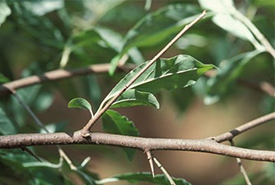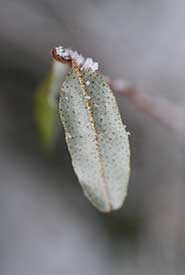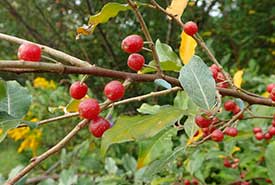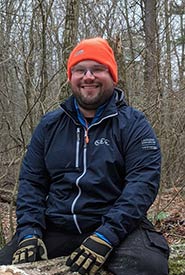Interns and olives

Autumn olive (Photo by James H. Miller)
When I started my Canadian Conservation Corps internship (a three-part program funded in part by the Canadian Service Corps, a youth-focused nature and conservation experience) with the Nature Conservancy of Canada (NCC) as a conservation technician in southwestern Ontario, I didn’t know much about invasive species. In fact, I didn’t know anything about autumn olive, which is one of the plants I came across in the area.
Characteristics of autumn olive

Autumn olive leaf (Photo by Nick LeBlanc, CC BY-NC 4.0)
Autumn olive is a small tree or shrub. The underside of the leaves are silvery, and in the fall it produces white-dotted reddish berries. This tree was planted throughout North America in the 1960 and 1970s by municipal land managers who thought they were doing good by providing food and cover for wildlife. Also, autumn olive berries are edible and, according to various cooking websites, make a pretty good purée! Sounds great!
Not so fast. Only a few decades later, we have now have learned a lot about ecology, and we now know that autumn olive is actually an invasive plant. By definition, a non-native invasive plant is:
- A plant that is not native to where it has been observed.
- A plant whose introduction causes environmental harm.
How to get rid of autumn olive

Autumn olive berries (Photo by squidface, CC BY-NC 4.0)
So how are we getting southern Ontario autumn olive-free? By killing it. To stop the plant from growing, it cannot just be cut or mowed. That would only make it re-sprout vigorously. Hand-pulling a few seedlings is fine but when the plant is bigger than your average dining table, it suddenly becomes harder to remove! The most effective method suggested by the Ontario Invasive Plant Council is to cut the stem in the fall and paint the stump with a small amount of appropriate herbicide. And I won’t eradicate it all on my own, that’s for sure.
There are a few things you can easily do to save and protect native plants and wildlife to guard against invasive species in general.
What you can do to curb the spread of invasive species
First, remove and replace non-native plants in your garden and backyard. Second, please don’t throw away yard waste just anywhere. Every municipality is different, so be sure to get the right information. Dispose of yard waste accordingly. If you dump it it might start taking over forests and other native habitat. Third, if you go hiking or biking on your local official trails (you should try Backus Woods if you haven’t), clean your shoes or bicycle tire treads between natural areas to help stop spreading unwanted species.
And lastly, spread the word, not the seeds, of invasive species. Talk about it to your neighbours and friends. Help the Nature Conservancy of Canada. Help the native species. Learn more about autumn olives at our resource page.


